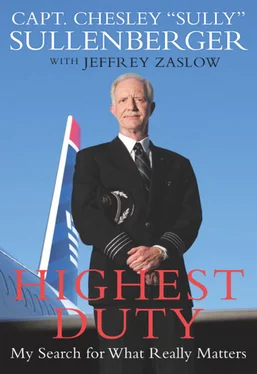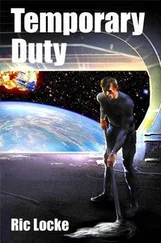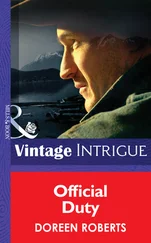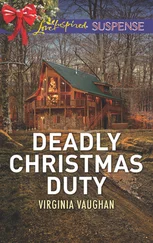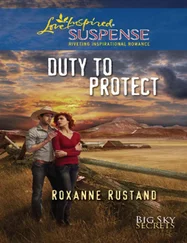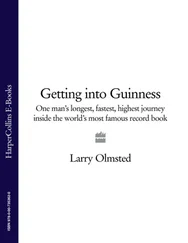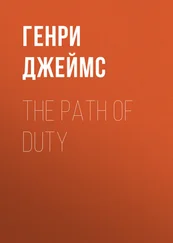On the runway, shortly after we started rolling, I said, “Eighty,” and Jeff answered, “Checked.” That was the airspeed check. Our language was exactly by the book.
Then I said, “V1,” an indication that I was monitoring the velocity of the airplane and that we had passed the point where we could abort our takeoff and still stop on the remaining portion of the runway. We were now obligated to continue the takeoff. A few seconds later, I said, “Rotate.” That was my callout to Jeff that we had reached the speed at which he should pull back on the sidestick, causing the aircraft to lift off. We were airborne and it was very routine.
At 3:25:44, from the controller to me and Jeff: “Cactus fifteen forty-nine, contact New York departure, good day.” We were being told that future communications for our flight were being handed off to the controller at New York Terminal Radar Approach Control, located on Long Island.
At 3:25:48, from me to the LaGuardia controller: “Good day.” To that point, my four-day trip had been completely unremarkable, and as with almost every other takeoff and landing I’d experienced in forty-two years as a pilot, I expected this flight to remain unremarkable.
We’d even made up a little time caused by the delays earlier in the day. So I was in a good mood. The Charlotte-San Francisco flight was still showing on time, and a middle seat was available. It looked like I’d make it home while Lorrie and the girls were still awake.
3. THOSE WHO CAME BEFORE ME
AS HUMAN ENDEAVORS go, aviation is a very recent one. The Wright brothers first flew in 1903. That’s just 106 years ago. I’m fifty-eight years old, and I’ve been flying for forty-two of those years. Aviation is so young that I’ve been involved in it for almost half of its history.
Through the efforts of many people in the past 106 years—their hard work, their practice, their engineering breakthroughs—aviation has quickly gone from its dangerous infancy to being so commonplace that there is little tolerance for any risk at all. We may have made it look too easy. People have forgotten what’s at stake.
I’m not saying passengers shouldn’t feel comfortable flying. It’s just that it’s easy to become complacent when our nation can sometimes go a year or two between major airline accidents involving fatalities. When things are going well, success can hide inefficiencies and deficiencies. And so it takes constant vigilance.
Long before I found myself in the cockpit of Flight 1549, I had closely studied other airline accidents. There is much to be learned from the experiences of pilots who were involved in the seminal accidents of recent decades. I have soberly paged through transcripts from cockpit voice recorders, with the last exchanges of pilots who didn’t survive.
I studied these accidents partly because, in the early 1990s, I had joined a couple dozen other US Airways pilots to help develop an air-safety course looking at CRM—crew resource management. Before Flight 1549, my proudest professional contribution was my work in CRM. My fellow facilitators and I helped change the culture of our airline’s pilot group by improving cockpit communication, leadership, and decision making. As First Officer Jeff Diercksmeier, my friend on the CRM team, said, “It was a time when a few people who really believed in what they were doing made a difference.”
My interest in air safety goes back to my first flights as a teenager. I’ve always wanted to know how some pilots handled challenging situations and made the best decisions. These were men and women worth emulating.
And so I tried to understand, intimately, the full stories behind each of these pilot’s actions. I’d ask myself: If I had been there, would I have been as successful?
A few years ago, I was invited to speak at an international conference in France focused on safety issues in a variety of industries. Given the comparatively ultrasafe record of commercial aviation, I was asked to appear on two panels to discuss how airline safety efforts might be transferable elsewhere. I talked about how other industries are recognizing that they can benefit by adopting some of our approaches.
This degree of safety requires tremendous commitment at every level of an organization and a constant diligence and vigilance to make it a reality.
Those of us who are pilots worry about the financial issues now weighing down airlines. Most passengers today select carriers based on price. If one airline’s fare is five dollars less than a competitor’s fare, the airline with the less costly ticket gets the booking. The net effect is that airlines are under intense pressure to lower their costs so they can offer competitive fares. This has cheapened the experience of flying; we’ve all seen the cutbacks in amenities offered in coach. But passengers don’t see other ways in which the airlines are cutting back. For instance, some of the smaller regional airlines have lowered the minimum requirements for pilot recruitment, and they’re paying some pilots $16,000 a year. Veteran pilots—those who have the experience that would help them in emergencies—won’t take these jobs.
I have 19,700 flight hours now. Back when I had, say, 2,000 or 4,000 hours of experience, I knew a lot of things, but I did not yet possess the depth of understanding I have now. Since then, I’ve sharpened my skills and learned from many situations that tested and taught me. Regional airlines will now take someone with 200 hours of flying experience and make him or her a first officer. These new pilots may have exceptional training, and they may have a high degree of ability. But it takes time, hour after hour, to master the science and art of flying a commercial jet.
Another issue: Airlines used to have more large hangars in which their planes were repaired and maintained by their own mechanics. The mechanics would overhaul component parts, radios, brakes, engines. They knew the specific parts and systems in each aircraft in their fleet. Now many airlines have outsourced their maintenance and component work. Are these outside mechanics as experienced and knowledgeable about a particular aircraft? If a part is sent overseas to be overhauled, does it come back as reliable?
It’s fair to say that when jobs are outsourced, and the work is done in a remote location, an airline has to work much harder to control the entire process, and to have the same level of confidence in the part or repair.
Every choice we in the airline industry make based solely on cost has ramifications and should be evaluated carefully. We have to constantly consider the unintended consequences for safety.
An airline accident is almost always the end result of a causal chain of events. If any one link was different, the outcome may have been different. Almost no accident was the result of just one problem. In most cases, one thing led to another, and then there was too much risk and a bad outcome. In aviation, we need to keep looking at the links in the chain.
Engine manufacturers know, for example, that their engines might someday encounter and ingest a flock of birds, causing severe damage. To learn what they’re up against, the manufacturers use farm-raised birds to test their engines. These preslaughtered birds are fired into the spinning blades from pneumatic cannons—sacrificed in the name of research that might save human lives. Given the growing population of birds near many airports, this testing is crucial.
Birds certainly are entitled to their wide piece of the sky, but if we humans are to continue joining them there in ever larger numbers, we’ll need to have a better understanding of the risks and remedies of bird strikes. In the wake of Flight 1549, investigators will likely consider whether an improvement in engine certification standards is needed.
Читать дальше
